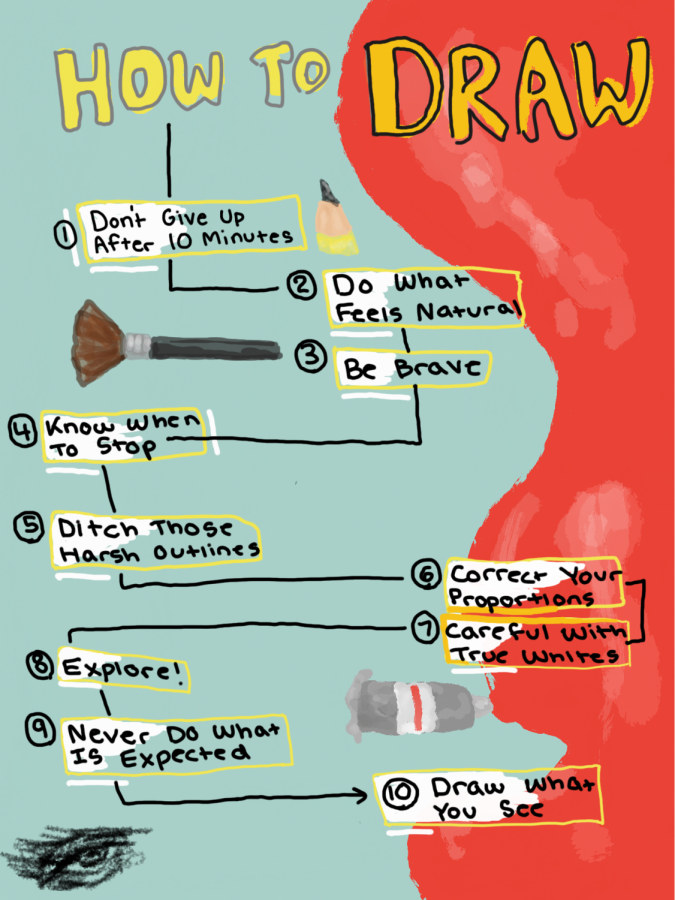How to Draw
From a beginner to Van Gogh himself
A visual representation of the steps necessary to learn how to draw.
As an artist, whenever someone walks by while I am drawing, one question always arises: “How do you do that?” Never really knowing what to say, I usually just give them a friendly laugh and shrug my shoulders. I could give them the basis of what I’ve learned and what they need to do to be able to draw, but I never do, doubting that they asked actually seeking a lecture.
However, though some people ask just to get their admiration across, there is a genuine desire amongst people to form shapes with their hands, to create beauty with a brush. Because of this, I am going to give you the answer to the question everyone asks. Here’s how to do draw:
Don’t Give Up After 10 Minutes
What most people tell me is “I just can’t get my hand to do what I see in my head.” Of course you don’t! You haven’t practiced yet – it’s as if Mozart sat down on a piano bench and was immediately able to write what he heard in his head. People seem to have the misconception that if they are not remotely good then they can’t become good. Let me tell you this: Monet did not paint the “Water Lilies” overnight, and he certainly did not paint them the first time he picked up a brush. In fact, Monet painted the first piece in the “Water Lilies” forty years after he started oil painting. Frustration might feel heavy, but if you put that pencil down after only ten minutes, you won’t get anywhere.
Do What Feels Natural
Art is all about capturing moments and depicting reality, which is why art needs to feel free and true to how one feels. Art that is forced is bad art, and if something doesn’t feel natural while drawing it, it isn’t right.
Be Brave
In art, you can’t sit comfortably\; I can assure that you will never grow if you do this. I attribute a large portion of my growth to taking risks in art, discovering many methods and approaches by trying something a little different. It’s incredible how much bravery matters in art, and sitting where you’re comfortable is a surefire way to stunt your growth.
Know When to Stop
Contrast to not working enough, you can overwork your art. We’ve all been in that “if I could just fix…” or “maybe if I just added…” place, but you have to ignore it. When you know that continuing would ruin your art you can’t keep going, even if your brain tells you to. Do not self sabotage by adding that stroke that you know won’t look good.
Ditch Those Harsh Outlines
No matter how good your shading is, if your drawing has harsh outlines, it won’t look good. Now, with a more stylistic approach, dark outlines can be pulled off, but if you’re taking a realism approach – which most beginners go for – it just won’t work.
Correct Your Proportions
No matter how frustrating proportions can be, they can make or break a drawing. If you want to become a good artist, you have to get forms, symmetry, and perspective right.
Careful With True Whites
In drawing with pencil or charcoal, we naturally tend to make the color of the object we see pure white. Pure white should be reserved for highlights, and sometimes shouldn’t even be present then.
Explore the World of Art
No matter how cliché it is, you have to explore different styles of art. Drawing has many, many different feels to it, and being well-rounded is important to being an artist. Try abstraction, realism, abstract realism, anything other than what you’ve been doing. You might even find a new style that you love.
Never Do What Is Expected
Do something strange: a gumball machine with flowers instead of gum, planets as eyes, bicycles with wheels made of twizzlers. Channel your inner child who wasn’t afraid of thinking outside of the box. Have fun in your art and surprise people with it. Tip: If you’re stuck, I recommend going online and finding a random word generator: draw whatever two things it gives you.
Draw What You See, Not What You Think You See
This may sound odd: how can you think you see something that is not what you actually see? Even though it doesn’t sound possible, it is far more common than you would believe. Remember when you were a kid how you would put a strip of blue across the very top of your paper and call it the sky? The sky falls all the way to the horizon in reality. This is an example of drawing what you think something looks like versus what it actually looks like. So when you draw, really, truly look at something, don’t modify it to fit what you think of it. Draw all the tiny details. This step is crucial to becoming a good artist and is used in every single moment of drawing. It is the hardest mental challenge to overcome, but once you break i t- which you will have to do multiple times – you will grow.
So, if drawing is something you strive to become better at, follow these steps. I guarantee you will grow and see improvement.




